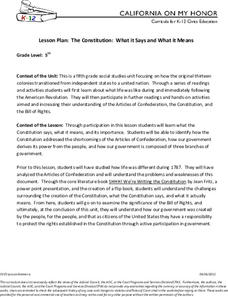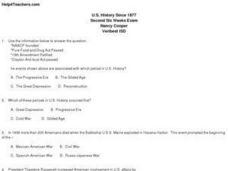Curated OER
American Focus on World Constitutions
Students describe demographic, economic, political and geographic features of the U.S., summarize events leading to the creation of the Constitution and describe the process of amending the Constitution.
National Endowment for the Humanities
The Creation of the Bill of Rights: “Retouching the Canvas”
While the Constitutional Convention lay the foundation of the new government for the United States, the protections given under the Bill of Rights were controversial. Using documents, such as James Madison's and Thomas Jefferson's...
National Endowment for the Humanities
James Madison: Raising an Army—Balancing the States and the Federal Government
To war! To war! Every nation in the history of the world has had to deal with warfare on some level. Scholars go through a series of activities and discussions surrounding the development of the Constitution to help them better...
Curated OER
Congress and the Creation of the Bill of Rights
Students participate in inquiry activities to explore powers outlined in the Bill of Rights. In this Bill of Rights lesson, students creation of a class Bill of Rights, evaluate and propose amendments, and analyze primary source...
Judicial Branch of California
Constitution Hall of Fame
Using a tableau activity, class members consider who they want to include in a Hall of Fame to honor the framer of the Constitution. Other activities include using a tableau to act out the various sections of the Constitution and related...
Curated OER
Bill of Rights and Ratification Notes
In this Bill of Rights activity, students fill in the blanks to sentences about the Bill of Rights. Students fill in the blanks to 5 sentences and answer 1 short answer question.
Curated OER
Religion in Public Schools
Students examine the presence of religion in public institutions. For this ethics lesson, students focus on one aspect of the presence of religion in public institutions, and the controversy surrounding religion in the public schools....
Curated OER
Breaking Barriers
Determine how African-Americans have broken barriers in this history lesson. Middle schoolers discuss the 15th Amendment and the American civil rights movement prior to analyzing Barack Obama's speech "A More Perfect Union," taking care...
Curated OER
We the People Lesson 2
Young scholars compare the Federalists and Anti-Federalists visions for the U.S. government. In this government instructional activity, students conduct research on Federalists and Anti-Federalists figures. Young scholars use their...
C-SPAN
Choice Board - Conversations with Suffragists
Celebrate 100 years of women's suffrage by planning a re-enactment of famous women discussing their fight. After learners view a series of interviews with famous women played by actors, including Susan B. Anthony, Sojourner Truth, and...
National Endowment for the Humanities
Lesson 2 James Madison: The Second National Bank—Powers Not Specified in the Constitution
How much power is too much power for the federal government? Scholars use primary documents and constitutional research in groups to analyze the creation of the Second National Bank under James Madison. This is the second lesson of a...
Curated OER
Paving the Road to the Constitution
Eighth graders argue for or against the ratification of the U.S. Constitution. In this U.S. government lesson, 8th graders complete four activities that encourage them to examine the strengths and weaknesses of the Articles of...
Curated OER
Bill of Rights Day
Fifth graders examine and identify the values and purposes of the Bill of Rights. They complete a class KWL chart, participate in a class jigsaw activity, write and illustrate a book about the first ten amendments, participate in a mock...
Curated OER
Bill of Rights Day (December 15th)
On December 15, 1791, the ratification of the first ten amendments to the Constitution of the UnitedStates of American by three-quarters of the states took place. These were subsequently incorporated into the Constitution and became...
Tennessee State Museum
Understanding Women’s Suffrage: Tennessee’s Perfect 36
Tennessee was the pivotal state in ratifying women's suffrage in 1920, with its vote coming down to one man: Harry Burn, a 24-year old state representative who changed his nay to an aye on the advice of his mother. Learn...
Judicial Branch of California
The Constitution: What It Says and What It Means
Learners get the chance to act as representatives to the Constitution Convention, and must decide whether or not to recommend your state ratify the new framework. After examining the Constitution line-by-line, they consider their...
Curated OER
Documents and Symbols and American Freedom
Students complete a unit of lessons on the documents, symbols, and famous people involved in the founding of the U.S. government. They create a personal bill of rights, write a found poem, design a flag, conduct research, and role-play...
Curated OER
U.S. History Since 1877
Students identify and analyze when the following occurred: the beginning of the NAACP, the enactment of the Pure Food and Drug Act, the ratification of the nineteenth Amendment, and the enactment of the Clayton Anti-trust Act. Students...
Curated OER
Real Life Rights
Learners consider modern applications to the Bill Of Rights (how does Ammendment 4 apply to locker searches?) students prepare and role play a mock trial to explore the finer points of the relevance ot the Bill of Rights in the 21st...
Curated OER
The Bill of Rights is a-Rockin
Students explore the U.S. Constitution through music. In this Bill of Rights lesson, students discuss a hypothetical case regarding lyrics by Madonna and the historical Massachusetts Blue Laws. Students use the Bill of Rights to support...
Curated OER
Paving the Road to the Constitution
Eighth graders assess the strengths and weaknessess of the Articles of Confederation as related to the United States and North Carolina. They demonstrate an argument for or against ratification of the United States Constitution.
Curated OER
Exploring the Bill of Rights
Students examine, discuss, and research the Bill of Rights. They, in groups, develop a presentation about their amendment for the class.
Curated OER
VA Statute for Religious Freedom, II. Matching Activity
Students read and analyze primary source documents. In this matching lesson, students read sections of the Virginia Statute for Religious Freedom. Students match the document sections with paraphrased sections and discuss the accuracy of...
Library of Congress
Women's Suffrage Movement Across America
An engaging resource provides many primary source materials to inform a study of the Women's Suffrage Movement. Suggestions include building a timeline of the fight, using the documents as the basis of a DBQ, and/or using a Venn...























